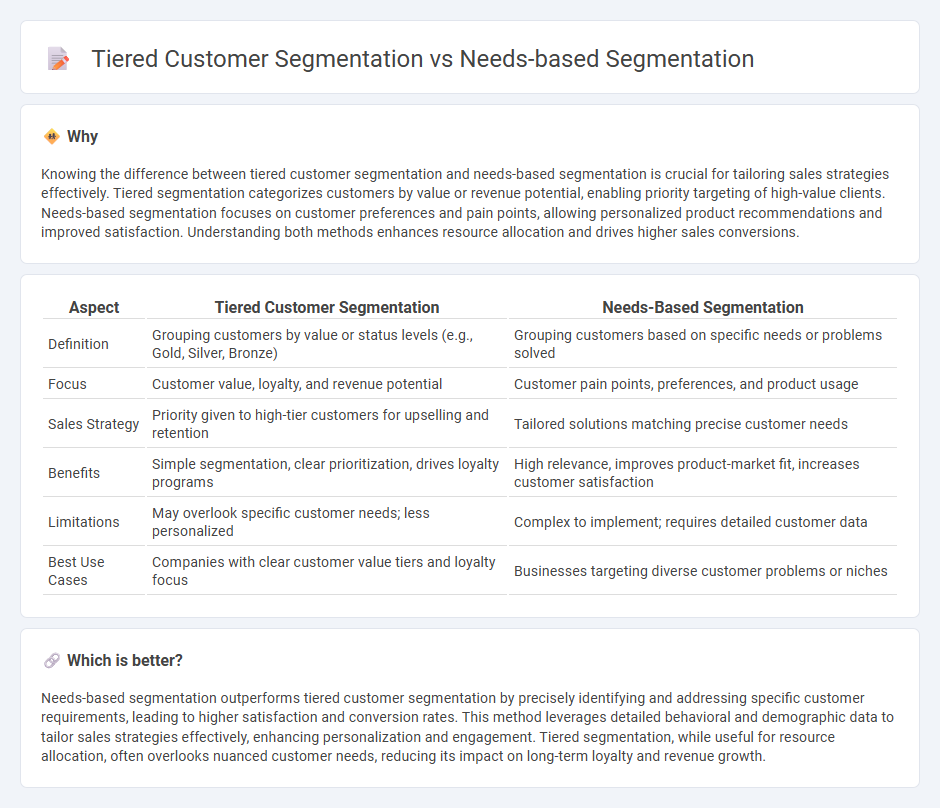
Tiered customer segmentation categorizes clients based on hierarchical levels such as spending capacity or brand loyalty, enabling targeted marketing strategies for each tier. Needs-based segmentation focuses on identifying specific customer requirements and pain points, allowing personalized solutions to increase satisfaction and retention. Explore the benefits of combining these segmentation approaches to optimize sales performance.
Why it is important
Knowing the difference between tiered customer segmentation and needs-based segmentation is crucial for tailoring sales strategies effectively. Tiered segmentation categorizes customers by value or revenue potential, enabling priority targeting of high-value clients. Needs-based segmentation focuses on customer preferences and pain points, allowing personalized product recommendations and improved satisfaction. Understanding both methods enhances resource allocation and drives higher sales conversions.
Comparison Table
| Aspect | Tiered Customer Segmentation | Needs-Based Segmentation |
|---|---|---|
| Definition | Grouping customers by value or status levels (e.g., Gold, Silver, Bronze) | Grouping customers based on specific needs or problems solved |
| Focus | Customer value, loyalty, and revenue potential | Customer pain points, preferences, and product usage |
| Sales Strategy | Priority given to high-tier customers for upselling and retention | Tailored solutions matching precise customer needs |
| Benefits | Simple segmentation, clear prioritization, drives loyalty programs | High relevance, improves product-market fit, increases customer satisfaction |
| Limitations | May overlook specific customer needs; less personalized | Complex to implement; requires detailed customer data |
| Best Use Cases | Companies with clear customer value tiers and loyalty focus | Businesses targeting diverse customer problems or niches |
Which is better?
Needs-based segmentation outperforms tiered customer segmentation by precisely identifying and addressing specific customer requirements, leading to higher satisfaction and conversion rates. This method leverages detailed behavioral and demographic data to tailor sales strategies effectively, enhancing personalization and engagement. Tiered segmentation, while useful for resource allocation, often overlooks nuanced customer needs, reducing its impact on long-term loyalty and revenue growth.
Connection
Tiered customer segmentation organizes clients into hierarchical levels based on value or behavior, enhancing targeted marketing effectiveness. Needs-based segmentation focuses on identifying specific customer requirements and preferences, tailoring offerings accordingly. Integrating both methods allows businesses to prioritize high-value tiers while addressing distinct needs, optimizing sales strategies and resource allocation.
Key Terms
Customer Needs
Needs-based segmentation groups customers according to their specific requirements, preferences, and pain points to tailor products and services effectively. Tiered customer segmentation organizes customers into hierarchical levels based on value, loyalty, or purchasing behavior, focusing on differentiated service offerings. Explore how understanding customer needs drives successful segmentation strategies.
Segmentation Criteria
Needs-based segmentation focuses on categorizing customers according to their specific needs, preferences, and behavioral patterns, enabling tailored marketing strategies that address individual motivations. Tiered customer segmentation, on the other hand, ranks customers into different levels or tiers based on criteria like purchase frequency, revenue contribution, or loyalty, emphasizing value-based prioritization. Explore the detailed advantages and applications of both segmentation criteria to optimize your customer retention and acquisition efforts.
Customer Value
Needs-based segmentation categorizes customers according to their specific requirements, preferences, and pain points, enabling personalized solutions that enhance customer satisfaction and loyalty. Tiered customer segmentation ranks customers based on their overall value or profitability, prioritizing resource allocation to maximize revenue from high-value segments. Exploring how these strategies impact customer value optimization can uncover tailored approaches to boost business growth.
Source and External Links
What Is Needs-Based Segmentation in Marketing? - Mailchimp - Needs-based segmentation divides a market into customer segments based on shared needs, priorities, and values, focusing on the underlying reasons people buy rather than demographic or geographic factors.
Needs-Based Segmentation: Definition, Examples, and Use Cases - This approach breaks down your audience into distinct groups according to their specific needs, preferences, or problems they aim to solve, enabling tailored messaging and offers for each segment.
Needs-Based Segmentation Overview | Experian Marketing - Needs-based segmentation groups people by their shared needs, allowing for more personalized marketing strategies and improved customer loyalty by addressing what truly matters to each segment.
 dowidth.com
dowidth.com